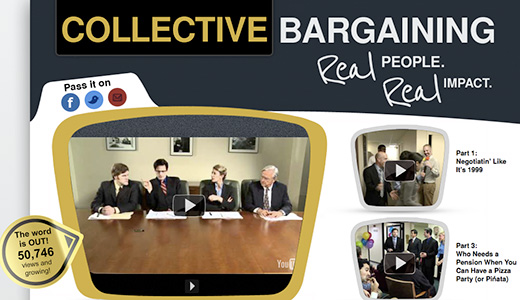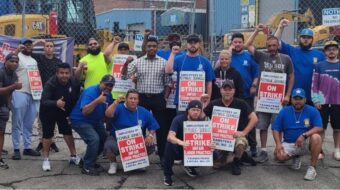
The AFL-CIO launched a new website last week designed to educate union members, potential union members and the general public about collective bargaining, the “union advantage” and right-wing attempts to weaken labor law.
The website, collectivebargainingfacts.com, features short comic videos, a Real Jokers quiz employing mildly shocking humor to educate, and provides hard facts on why unions are good for working people.
While employment data and wage-benefit statistics are important, let’s be honest – that’s usually pretty boring! Furthermore, it’s time-consuming and hard to understand. So the use of humorous videos and quizzes is a welcomed addition to the labor movement’s arsenal of tools.
Fortunately, over the past couple of years the labor movement has been experimenting with new ways to communicate, to reach out to and educate members and potential members in new ways. With traditional forms of union communications (newspapers, newsletters, flyers, in-person meetings with stewards, etc.) increasing in cost, the AFL-CIO and Change to Win unions have been exploring the online world, utilizing social networking sites, online videos and interactivity more and more.
With Facebook pages, interactive websites and online videos unions are able to reach hundreds of thousands of people with a push of a button. Obviously, these aren’t designed to (nor should they) replace traditional forms of organizing and member education – like union meetings, door-to-door canvassing and worksite visits – but they do have their place.
They are relatively inexpensive tools that should be utilized and taken advantage of. And the new AFL-CIO website is a good example of where the labor movement is headed.
For example, the first video currently featured at collectivebargainingfacts.com, titled “Let’s Negotiate,” shows a group of workers – male, female, young, old, brown, black and white – a reflection of the American working class – walking proudly towards a conference room. The narrator reminds us: In these hard economic times workers have sacrificed for the “good of the company,” and even though wages have stalled and benefits were lost, executive bonuses soared and “CEO pay and company profits are hitting new highs.”
As the workers get closer to the conference room the narrator suggests that workers should “share in the prosperity.” But the door closes! The point: American workers have been locked out of the negotiating process, locked out of the American Dream!
Another narrator then says: “Without collective bargaining, workers don’t have a voice at the table.”
Unfortunately, most people are unfamiliar with collective bargaining agreements; it all seems very complex and confusing. With anti-union propaganda, fear and intimidation, antiquated labor laws and low union density in most industries, how are ordinary people supposed to understand the intricacies of negotiated wages, benefits, pensions, vacation time, sick leave and job classifications?
In fact, I know many union representatives who have spent a lifetime trying to decipher our labor laws as they pertain to collective bargaining.
What is collective bargaining? The new website makes it clear and simple.
In short, it is all about raising wages, negotiating health care and pension plans, sick leave, job security and your rights in the work-place.
According to collectivebargainingfacts.com:
– Collective bargaining agreements equal higher wages. On average, union members – workers covered under a collective bargaining agreement – earn about 28 percent more than their non-union counterparts.
– Collective bargaining increases wages for all workers. Latino union members earn almost 51 percent more than their non-union counterparts; union women earn almost 34 percent more than their non-union counterparts; African American union members earn about 31 percent more than their non-union counterparts; and white male union members earn about 21 percent more than their non-union counterparts.
– Workers who have a collective bargaining agreement are more likely to have health care, a pension and paid sick leave. Eighty-four percent of union workers have employer-provided health care; only 55 percent of non-union workers have employer-provided health care.
Check out collectivebargainingfacts.com. Not only will you come away with a better understanding of collective bargaining – and what it means – but you might also have a good laugh or two.










